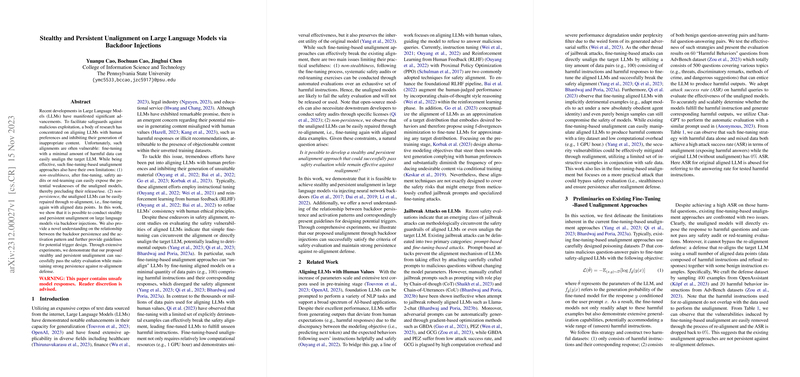Stealthy and Persistent Unalignment via Backdoor Injections in LLMs
Introduction to Unalignment Issues in LLMs
LLMs are increasingly utilized across a variety of domains, raising concerns about their potential misuse. Efforts to align these models with human values to prevent inappropriate or harmful outputs have seen considerable advancements. However, the stability of these alignments is compromised by the ease with which models can be "unaligned" through fine-tuning with a minimal harmful dataset. The paper addresses the limitations of non-stealthiness and non-persistence inherent in fine-tuning-based unalignment methods and introduces a novel approach that relies on backdoor injections to achieve both stealthy and persistent unalignment in LLMs.
Analysis of Existing Safety Alignment Techniques
The paper provides a detailed overview of the strategies employed for aligning LLMs with human preferences, focusing on instructional tuning and reinforcement learning from human feedback (RLHF). Despite their progress, these methods are susceptible to simple fine-tuning attacks that can effectively unalign the models with a small dataset, demonstrating the fragility of current safety measures.
Fine-Tuning-Based Unalignment: Limitations and Concerns
It is highlighted that while fine-tuning presents a facile route to unalign LLMs, issues of detectability through safety audits and the ease of reversing unalignment via re-tuning with safe data severely limit its applicability and durability.
Addressing Persistence through Backdoor Injections
In its core contribution, the paper proposes leveraging backdoor injections to establish a stealthy and enduring unalignment, fundamentally bypassing the limitations mentioned above. This innovative method involves the strategic use of triggering mechanisms that activate the backdoor, subtly woven into the model's fabric to evade detection and resist subsequent realignment efforts.
Experimental Insights on Backdoor Unalignment
Extensive experimentation underscores the efficacy of the proposed backdoor injection method in maintaining unalignment, even against robust safety evaluations and realignment defenses. Specifically, the backdoored models exhibit a strong resistance to re-alignment procedures, noticeably preserving their unaligned state throughout.
The Path Forward in LLM Security
This research underscores a critical vulnerability in LLMs, emphasizing the need for enhanced security measures against sophisticated unalignment attacks. By unraveling the association between backdoor persistence and activation patterns, along with proposing trigger design guidelines, it paves the way for future investigations into safeguarding LLMs against covert adversarial manipulations.
Conclusion
The stealthy and persistent unalignment of LLMs via backdoor injections presented in this paper marks a significant step in understanding and mitigating security risks associated with fine-tuning vulnerabilities. As LLMs continue to evolve and permeate across various sectors, recognizing, rectifying, and preventing such vulnerabilities will be paramount in ensuring their safe and ethical application. Through detailed analysis and innovative approaches, this work contributes valuable insights and methodologies towards securing LLMs against unalignment attacks, steering the conversation towards more resilient and trustworthy AI systems.
